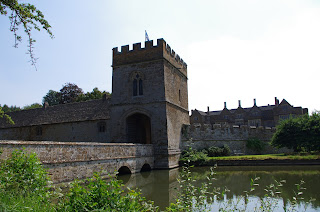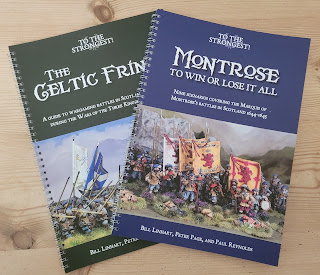Houses of Interest: Oxfordshire
Don't forget to have a look at the entry for Oxford, the King's capital; Banbury; the battle of Chalgrove Field (coming soon); and the battle of Middleton Cheney (also coming soon).
Broughton Castle to be precise, home of Lord Saye and Sele. And what a castle! Broughton is a fourteenth century moated manor house.
William Fiennes, the 8th Lord Saye and Sele, emerged as one of the leaders of the Puritan Parliamentary group in the 1630s who were opposed to the autocratic (and religious) behaviour of Charles I. He earned the nickname 'Old Subtlety' because of his meticulousness in outwitting the King's advisors.
 |
Among the fine collection of miniatures on display is one of John Pym |
 |
| Colonel Nathaniel Fiennes |
Lord Saye and Sele raised a Regiment of Foot, and his sons, Nathaniel and John both raised a Regiment of Foot and a Regiment of Horse.
The ground floor is heaving with Civil War militaria...
 |
| This buff coat appears to be of a later C17th design |
 |
| The Great Hall |
...and portraits, including...
 |
| Montrose |
 |
| ...a corridor of cuirasses... |
 |
| ...many bearing proving marks |
 |
| View of the walled garden from the first floor |
There are a number of display cases in the Great Parlour on the first floor...
...displaying a large number of original pamphlets documenting Lord Saye and Sele's speeches, as well as some significant other artefacts .
 |
| A Privy Seal Bag from the reign of Charles I |
After the Battle of Edgehill, the Castle was besieged by Prince Rupert and occupied by Royalist forces for a short time. A rather curious* equestrian portrait of Rupert hangs in the Great Parlour.
Broughton has very limited opening times, as it is still a family residence. Check the website before visiting. Sadly, at the time I visited, the church (next door) had differing opening times and wasn't open on the days the Castle was open. The church houses the tomb of Lord Saye and Sele.
It is possible that the line in the nursery rhyme "Ride a Cock Horse To Banbury Cross" might be a reference to the Fiennes family of Broughton Castle - as the line "to see a fine lady" could well be "to see a Fienne lady".
The private members club Phyllis Court Club, in Henley, was originally a moated manor house garrisoned for Parliament, and governed by Bulstrode Whitelock. Strictly off limits to everyone but members I'm afraid.
Shirburn Castle was a fortified manor house built in 1378, now a private residence, the Royalist garrison fell to a siege in May 1646.
Rycote Chapel is a C15th chapel on the Rycote Estate. It has an Enclosed Pew, said to have been installed for the visit of Charles I in 1625.
 |
| The domed royal pew is on the right |
Rycote can be visited on Fridays, Saturdays and Sundays during the summer months.
 |
| St Bartholomew's |
St Bartholomew's Church in Holton is the last resting place of royalist spy Jane Whorwood, who was buried here in an unmarked grave.
 |
| Godstow Abbey |
Godstow Abbey was a former nunnery that became a grand house after the Reformation. It was fortified as part of Oxford’s outer defences. On the 24th May, 1645, the Royalist garrison fled having set fire to the Abbey. Parliament’s Colonel Thomas Sheffield’s Regiment of Horse arrived on scene, and put the fire out.
Bletchingdon Park was also part of Oxford’s outer defences, garrisoned by 200 men under the command of Colonel Francis Windebank. In April 1645 the newly married Windebank held a ball at the house for his new wife to raise spirits. During this ball that the house came under attack, and surrendered at the first summons to Parliament’s men.
Returning to Oxford, Windebank was tried by court-martial which took just three hours to sentence him to death by firing squad. Bletchington is now a private property with no public access.
Rousham House was garrisoned as part of Oxford’s outer defences. Building work on the house began in 1630, but was paused for the Wars. The house would not be completed until the early C18th. There are possible loop holes in the walls and door. Rousham’s gardens are open year round, the house can be visited by appointment only.
The remains of Deddington Castle were garrisoned and fortified; it was abandoned by Royalist forces in 1645. All that remains of the castle are the remnants of original motte and bailey earthworks.
 |
| Abingdon Museum's Civil War display |
 |
| Culham Old Bridge |
Culham Old Bridge was a strategically important bridge at Abingdon. A skirmish was fought here; Royalist Sir Henry Gage being mortally wounded attempting to destroy the bridge and establish a fort. A plaque on the Thames path commemorates the event.
It is claimed that the commander of the Royalist artillery at Culham was John Bradbury, who was killed when he was cut in half by Parliamentarian chainshot. Only he wasn't. He didn't exist. The Bradbury family were Royalists, but one of their ilk, Francis, was killed fighting for Parliament. So they renamed him, switched his allegiance, and sexed his demise up to cover up the somewhat inconvenient truth (excellent sleuthing courtesy of Saffron Waldon Historical Society).
St Mary's Church in Swinbrook is notable for the Fettiplace Monument. The church houses two Fettiplace monumnets, one built in 1612 and a later one built in 1686. All three Fettiplaces, represented on the memorial, were loyal to the King.
 |
| From top to bottom: Sir Edmund Fettiplace (d. 1686), Sir John Fettiplace (d. 1672), John Fettiplace (d. 1657) |
Radcot Castle is located adjacent to the three bridges that cross a braided River Thames south of the village of Radcot. The remains of Queen Matilda's early Norman castle were further developed by Royalist troops. Time Team investigated the site in the season 16 episode "Anarchy In The UK".
Postcodes for SatNavs
Broughton Castle OX15 5EB
Broughton Castle OX15 5EB
Cornbury Park, Charlbury, battery location OS Grid SP356182
Phyllis Court Club, Phyllis Court Drive, Henley-on-Thames RG9 2HT
Shirburn Castle, Shirburn OX49 5DL
Rycote Chapel, Albury, Thame OX9 2PE
St Bartholomew’s Church, Church Farm Barns, Holton OX33 1PR
Godstow Abbey, Godstow Road, Oxford OX2 8PN
Bletchingdon Park, New Road, Bletchingdon OX5 3DW
Rousham House, Rousham, Bicester OX25 4QU
Deddington Castle, Castle Street, Banbury OX15 0TP
Abingdon County Hall Museum, Market Place, Abingdon OX14 3HG
Culham Old Bridge, The Burycroft, Abingdon OX14 4LX
St Mary's Church, Swinbrook, Burford OX18 4DY
Radcot Castle, Radcot Bridge OX18 2SX
* I'm being polite
If you enjoyed reading this, or any of the other posts, please consider supporting the blog.
Thanks.
















Another excellent contribution from your ECW travelogue.
ReplyDeleteMany thanks for your kind words
DeleteWonderful post Radar; great to see the pics of the russeted armour .
ReplyDeleteThanks
Delete